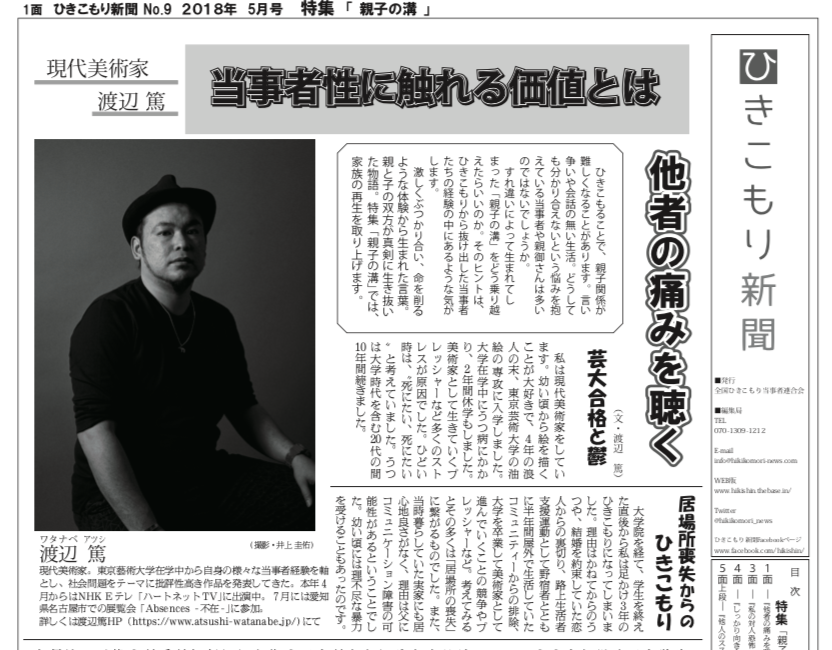Japan’s Most Interesting Newspaper Is for Recluses, by Recluses
Fed up with sensationalized portrayals, the country’s hikikomori are reclaiming their narrative.

A distraught mother gestures to the camera crew to tread softly as they approach her teenage son’s bedroom. A mound of moldy garbage lies at its entrance, which is barricaded with a screen. The interviewer asks whether her son washes himself, and the mother fights back tears. Once every six months, she answers.
In 2002, the BBC documentary “Mystery of the Missing Million” brought the plight of Japan’s social recluses, the hikikomori, to mainstream English-language media. Angry teens playing video games in isolation, ashamed parents speaking off-camera about physical abuse from their withdrawn offspring, and news reports of mentally ill hikikomori as kidnappers and murderers created a wildly imbalanced portrait of the million or more Japanese who live in self-confinement (a number that itself might be overblown).
These depictions continue today. In January, Korean pop star Bang Yong-guk released a hit single, “Hikikomori,” in which he sings with crescendoing anguish about darkness and loneliness in a room strewn with papers and broken furniture. Around the same time, BBC News released another documentary short about Japan’s rental sisters: an $8,000-per-year rehabilitation program that sends social workers to try to coax recluses out of their rooms. In the film, one such rental sister recounts a hikikomori trying to strangle her.
To many hikikomori, this dire image is misleading and self-defeating. “[BBC] have made a serious mistake by broadcasting a false message to the world,” a hikikomori (who did not want to be named) tells me over email. “This is very sinful.”
As a group of shut-ins, hikikomori face a unique challenge in trying to speak for themselves. But for more than two years now, current and former hikikomori have participated in a unique project to correct these perceived mischaracterizations: their very own newspaper. The endeavor may well be helping participants come out of eremitism.

Naohiro Kimura, a 34 year old from Tokyo, launched Hikikomori Shimbun (Hikikomori News) in November 2016, after emerging from a decade spent as hikikomori, when he couldn’t bring himself to take his law school entrance exams and instead shut himself in to study. Hikikomori Shimbun, which publishes every alternate month, profiles individual hikikomori and provides news and resources for recluses and their parents, such as a list of events and support groups focused on reintegrating this collective of outcasts.
Hikikomori, which means “withdrawal,” refers both to the condition of withdrawing from society, as well as to the group of people experiencing it. The term was coined by Tamaki Saitō, a Japanese psychiatrist who decided to write a book about the condition in 1998, after a decade of seeing lethargic teenagers, who refused to leave the house or go to school, brought into his office by bewildered parents. He applied the term to individuals who had withdrawn into the home for a period of six months or more, but the contours of the condition are debated, especially whether it should be seen as a psychological illness or a social disease.
“As hikikomori is deemed shameful, they do not want to talk about their experience,” writes Kimura, over email. “This allows those with no experience of hikikomori to freely accuse them. However, accusations only set prejudice in society against the hikikomori, and further prevent them from reconnecting with society.” With the publication of Hikikomori Shimbun, he hopes to improve understanding of this group, and to foster empathy between hikikomori, their caregivers, and Japanese society.
In the initial months after launch, Kimura traveled all over Japan to promote the paper, and sold 6,000 copies within six months. From an original team of 15 collaborators, it now has more than 100 volunteers contributing articles and editorial support. Nearly all of them are either current or former hikikomori, and one of the first volunteers was a man who had been hikikomori for 30 years. The paper, published digitally, also has a print version that sells for 500¥ ($4.50). Sales of the print version, supplemented with Kimura’s own savings, cover operating costs. Approximately once a month, he holds editorial meetings in his apartment to plan and discuss future issues.
“I think it’s great that the hikikomori themselves are trying to speak up, and I think it’s very important for them to do so,” says Sachiko Horiguchi, an anthropologist and professor at Temple University’s Japan Campus, adding, “I’m not too sure about the actual impact they are having in mainstream society. I’m not sure how popular or widely read the paper is.”
The primary mission of Hikikomori Shimbun is to offer an alternative, insider’s perspective to sensationalized and sometimes inaccurate reporting. When media coverage widely implied that hikikomori is a uniquely male phenomenon, Hikikomori Shimbun subverted that narrative by bringing out a special issue on female hikikomori. When the government released a survey saying there were 540,000 hikikomori between the ages of 15 and 40, Hikikomori Shimbun did a series on middle-aged and aging recluses, a demographic ignored in the survey. Last August, the Japanese Cabinet Office announced they would conduct a survey of aging hikikomori.
A crucial conversation about hikikomori is the question of why so many Japanese isolate themselves and how to rehabilitate long-term recluses. Over email, Kimura writes that it was very important to him that his mother sought help from Tamaki Saitō, instead of ignoring his hikikomori symptoms like his father was doing. And yet, both Horiguchi and Kimura resist the excessive medicalization of hikikomori, which they say oversimplifies the problem and objectifies hikikomori as solely mentally-ill.
Instead, they argue for the importance of considering a variety of sociological factors, which include family pressure to succeed and labor market practices that are ageist or unaccommodating to hikikomori who have been out of the workforce. Bullying at school and pressure from parents to succeed are additional factors. While the internet affords hikikomori some semblance of social contact, it is also viewed as an enabler, allowing young adults an escape into the virtual world of video games.
“I think the argument suggesting that hikikomori are victims versus the argument that suggests they are lazy people who are not fulfilling their social responsibility, that society does not need to help them, are always competing with each other,” says Horiguchi. In her research, she has found that the majority of hikikomori who are represented in the discourse are middle- to upper-middle class, because they have the means to seek support, and can also go without an income for years.*
Anne Allison, a cultural anthropologist at Duke University, writes about the Japanese problem of muenshakai or “relationless society,” a word that encapsulates isolation and fraying social connectedness. Although the Japanese have a term for this, a disconnected society is not unique to Japan. Neither is the phenomenon of hikikomori, says Horiguchi. The anthropologist has been collaborating with French psychologists, sociologists, and anthropologists to apply the experts’ understanding of hikikomori to similar cases in France. Studies have found cases of hikikomori in South Korea, Spain, and the U.S. as well. Moreover, Hikikomori Shimbun is translated into Italian, indicating interest and readership there.

The problem of hikikomori in Japan is pervasive enough that a robust rehabilitation industry has emerged. However, Kimura says, many organizations are mercenary institutes cashing in on this vulnerable group and their parents. NHK, Japan’s national public broadcast media organization, ran an investigative story in 2017 about agencies that charged the equivalent of over $51,000 for a three-month dormitory stay with other hikikomori. The report mentions hikikomori who ran away from such a facility after being physically abused and denied food. More than 400 rehabilitation facilities exist in Japan today.
For Shimbun’s editor-in-chief, a multi-pronged approach to rehabilitation, one that combines family group therapy with programs that offer strategic rehabilitation, such as employment, education, and vocational training, is necessary to bring these recluses back into the fold. But such a collaborative approach to hikikomori is sorely lacking, he writes. According to Horiguchi though, Japanese state-sanctioned guidelines offer an identical three-step rehabilitative model of hōmon (visiting support), ibasho (“a place to be”/community space), and shūrō (employment support).
Kimura’s labor of love is one of the few ways in which hikikomori themselves are proactively participating in connecting with the outside world, albeit through the medium of writing. By telling other hikikomori what they’re going through, Kimura hopes his writers will realize that they are helping hundreds of thousands of silent hikikomori, and that their work has value.
In an interview with NHK World, Kimura expressed joy that some of his staff members had used their work at the newspaper to gradually come out of withdrawal. Some leveraged their experience at Hikikomori Shimbun to seek further employment. “One of them even became a journalist!” said Kimura, beaming.
*Correction: A previous version of the article stated that the majority of hikikomori are middle- to upper-middle class. It has been edited to reflect that the majority of representations of hikikomori show them as belonging to the middle- to upper-middle class.












Follow us on Twitter to get the latest on the world's hidden wonders.
Like us on Facebook to get the latest on the world's hidden wonders.
Follow us on Twitter Like us on Facebook